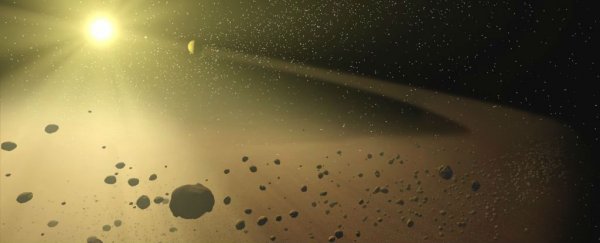It's not every day that we have permission to throw "Aliens?" out there in relation to a confounding astronomical discovery - in fact, I don't think we ever have. But the discovery of a strange pattern of light surrounding a distant star called KIC 8462852 has seen even the most sensible astronomers throw their arms up with a, "Sure, why not?" arguing that the possibility of advanced alien technology can't reasonably be ignored.
"Aliens should always be the very last hypothesis you consider, but this looked like something you would expect an alien civilisation to build," Jason Wright, an astronomer from Penn State University in the US, told The Atlantic.
First up, though, a little about the star in question: KIC 8462852. Located about 1,500 light-years away between the Cygnus and Lyre constellations of our Milky Way galaxy, KIC 8462852 is brighter, hotter, and more massive than the Sun.
It was first discovered by NASA's Kepler Space Telescope in 2009, and scientists have been tracking the light it emits ever since, along with the light of another 150,000 or so newly discovered stars. They do this because it's the best way to locate distant planets - slight, periodic dips in a star's brightness signal the fact that it might have one or more large objects orbiting it in a regular fashion.
These brightness dips are usually very slight, with the stars dimming by less than 1 percent every few days, weeks, or months, depending on the size of the planet's orbit, says astronomer Phil Plait at Slate.
What makes KIC 8462852 such a strange star to study is that not only are there way more dips of brightness than expected, these dips are highly irregular. There's no periodic orbiting going on here, just a bunch of strange, light-blocking shapes with no discernible pattern to them.
And these dimming effects are significant. Scientists are reporting that at one point, the amount of starlight dropped by 15 percent, and then at another, 22 percent. And this tells us a whole lot, says Plait:
"Straight away, we know we're not dealing with a planet here. Even a Jupiter-sized planet only blocks roughly 1 percent of this kind of star's light, and that's about as big as a planet gets. It can't be due to a star, either; we'd see it if it were. And the lack of a regular, repeating signal belies both of these as well. Whatever is blocking the star is big, though, up to half the width of the star itself!"
The most obvious explanation for hundreds of irregular dimming events is that KIC 8462852 has a mass of space junk - all kinds of rocks and dust of varying shapes and sizes - circling it in tight formation, says Ross Andersen at The Atlantic. The only problem is that this only occurs when a star is young, and the evidence points to KIC 8462852 being mature. "If it were young, it would be surrounded by dust that would give off extra infrared light," says Andersen. "There doesn't seem to be an excess of infrared light around this star."
"We'd never seen anything like this star," one of the researchers, Tabetha Boyajian from Yale University in the US, told him. "It was really weird."
So what's going on here? There are a number of reasonable possibilities to consider, and yep, aliens is actually one of them. First off, the scientists have already ruled out the possibility that the information they're working with is faulty. "We thought it might be bad data or movement on the spacecraft, but everything checked out," says Boyajian.
The best explanation we have is that at one point, another star passed into KIC 8462852's system and the disturbance of gravity caused a huge mess of comets to be pulled in towards it before being expelled again. And there just so happens to be another star close enough to KIC 8462852 to make this a possibility.
"But that would be an extraordinary coincidence, if that happened so recently, only a few millennia before humans developed the tech to loft a telescope into space. That's a narrow band of time, cosmically speaking," says Andersen.
And then there's the question of the 22 percent dimming. Could a mass of comets really block that much light? When astronomer Jason Wright from Penn State got a look at the data, he said we need to consider that perhaps we've caught an advanced alien civilisation in the process of building something massive near KIC 8462852.
Plait points to the so-called Dyson Sphere from several science fiction stories: a gigantic sphere made of solar panels that completely encircles a star. And he's not opposed to the idea:
"I actually kinda like it. I'm not saying it's right, mind you, just that it's interesting. Wright isn't some wild-eyed crackpot; he's a professional astronomer with a solid background. As he told me when I talked to him over the phone, there's 'a need to hypothesise, but we should also approach it skeptically' (paraphrasing a tweet by another astronomer, David Grinspoon), with which I wholeheartedly agree."
What does that mean? It means we're allowed to get a little bit excited! Not because aliens are a likely possibility, but because we're in the middle of an awesome mystery the likes of which we haven't seen before in the history of space exploration. Word is that SETI (Search for Extraterrestrial Intelligence) Institute scientists are considering devoting their time to it, and hopefully more research teams will get involved too. We seriously cannot wait to see what they come up with.
